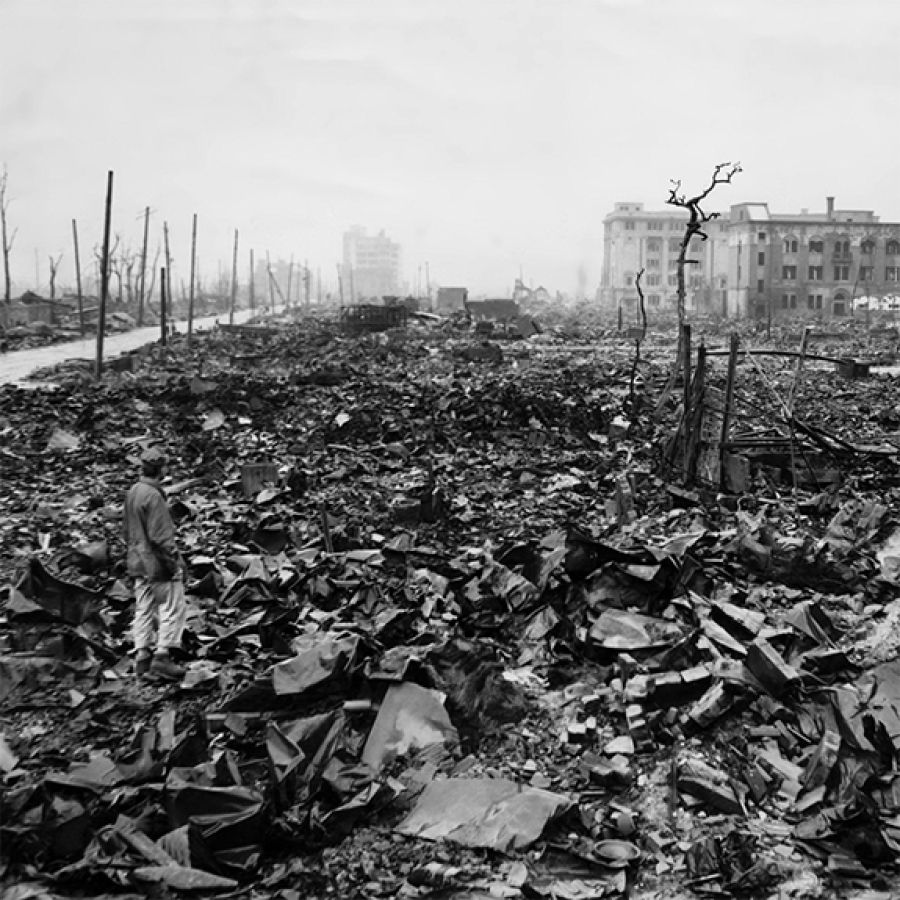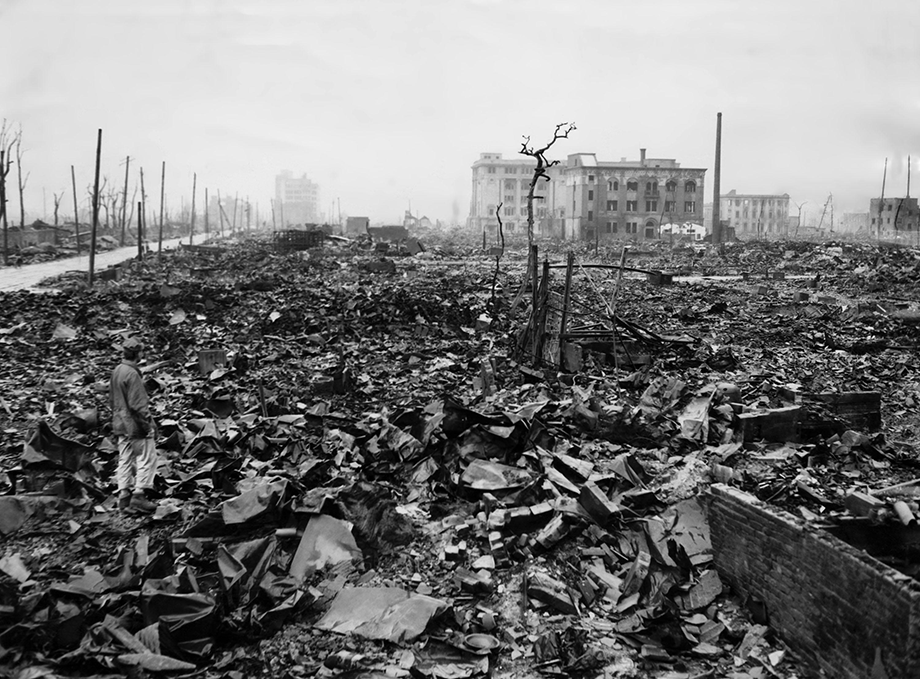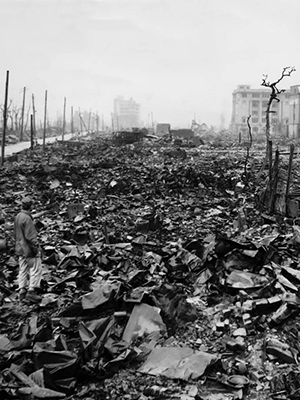
- Free Article: No
- Contents Category: Commentary
- Custom Article Title: ‘“Without undue suffering”: Japan’s August 1945 and the superweapon alibi’
- Review Article: No
- Article Title: ‘Without undue suffering’
- Article Subtitle: Japan’s August 1945 and the superweapon alibi
- Online Only: No
- Custom Highlight Text:
Just after midnight on 6 August 1945, twelve United States military personnel on Tinian Island in the north-western Pacific Ocean had an early breakfast of eggs, sausages, and pineapple fritters. After prayers with a Lutheran chaplain, they boarded a Boeing B-29 Superfortress heavy bomber for a six-hour flight to Japan. Each carried a pistol, and their commander secretly carried a metal box holding twelve cyanide capsules, for use in case of capture. Their aircraft carried a nuclear bomb which would soon be dropped on Hiroshima, a city in the west of Honshu, Japan’s largest island. Accompanying them was a second bomber carrying instrumentation to measure the blast effects, and a third carrying photography equipment. Weather reconnaissance aircraft had departed earlier, to ensure conditions were suitable for the attack.
- Article Hero Image (920px wide):

- Article Hero Image Caption: Hiroshima, 1945 (CSU Archives/Everett/Alamy)
The bomb was released from a height of 9,450 metres at 17 seconds past 8:15 am. It detonated 43 seconds later, 580 metres above a hospital near the centre of Hiroshima. The bomb was simple in design: one lump of highly enriched uranium was fired at very high speed into another, starting a nuclear chain reaction. The resulting explosion, a fraction of a second later, released a force of 16,000 tons of TNT. It raised the temperature at ground level to 7,000 degrees Celsius, hotter than the surface of the sun. The heat vaporised people and melted bronze statues. Shockwaves travelling faster than the speed of sound destroyed most buildings. A heavy downpour of black rain carrying radioactive material contaminated the city. More than 70,000 people died immediately. Killing large numbers of civilians was the bomb’s primary purpose. Military targets were a secondary consideration. The US postwar bomb damage assessment showed that Hiroshima’s munitions factories on the periphery of the city were largely unscathed.
Three days later, the United States dropped a second bomb on the city of Nagasaki. This bomb was made up of plutonium rather than uranium and was more powerful than the first. The Japanese government offered to surrender the next day. The apparently coercive power of the two bombs helped justify the construction of ever more lethal nuclear weapons after the war. Today, there are nine nuclear-armed states: the United States, Russia, the United Kingdom, France, China, India, Pakistan, North Korea, and Israel. They all continue to modernise their arsenals.
An examination of the historical record is in order. As Geoffrey Blainey observed in The Causes of War (1988), ‘The process by which nations evade reality is complicated.’
A ‘national mythology explains away defeats and enshrines victories’. The United States and Japan share a myth that the bombing of Hiroshima on August 6 and Nagasaki on August 9 resulted in Japan’s offer to surrender unconditionally on August 10. Tokyo and other major Japanese cities had already been bombed extensively for months, and Hiroshima and Nagasaki were small in comparison. They were about as far from the nation’s capital as it is possible to be in mainland Japan – 700 and 950 kilometres away respectively. In both countries, as well as in the wider world, the belief persists that the two nuclear weapons produced an outcome within a few days that months of sustained conventional bombing could not. As Blainey wrote forty years after the events:
Warfare appeared to be transformed. The bombs gave the impression of overwhelming success because they seemed to end the war in the Pacific, crushing the spirit of a nation which hitherto had seemed defiant, and dramatically shortening a war which was not expected to end until after the American forces invaded the Japanese islands in 1946.
Thus, a nuclear weapon was shown to have an irresistible psychological power to coerce an enemy. It also helped Japan’s militarists explain away their defeats.
The real reasons for Japan’s surrender, and its deliberations leading up to it, cast a different light on the nature and significance of nuclear weapons. In the months before the nuclear bombings, Japan’s war planners were in a catastrophic position, both militarily and politically. At the military level, they had launched aggressive wars, colonised Korea, occupied China, attacked Malaya and, an hour later, attacked a military base on a US colony. That last attack, on Pearl Harbor, is the best-known one. However, the most serious Japanese atrocities had already been committed in China. Japan’s forces had become notorious for experiments using poison gas and chemical warfare on live prisoners. They had committed sexual slavery, torture, executions, and other crimes, including mass atrocities against enemy civilians and soldiers. And now they were facing defeat. The United States and its allies had imposed a submarine cordon to block Japan’s supply of food, fuel, raw materials, and military reinforcements. In March 1945, US air power had inflicted the single most destructive attack on a city in the history of war – the firebombing of Tokyo – killing around 100,000 people in a single night.
With defeat looming, Japan’s leaders faced a political crisis because they hadn’t disclosed to the public just how dire the military situation really was. They had no way to justify their disastrous, criminal militarism. The August 6 nuclear attack on Hiroshima destroyed most of the city and killed more than 70,000 people immediately or shortly after the blast. But notably, that figure was substantially lower than the deaths in Tokyo, five months earlier. Nor was the destruction confined to these cities; the allied air campaign had targeted sixty-six Japanese cities with incendiary and high-explosive weapons before Hiroshima, and almost a third of them had suffered even more destruction.
Japan had a secret nuclear weapons program of its own, and several of its war planners understood the nature of the weapon used against Hiroshima. Hiroshima’s governor advised them immediately of the scale of the damage. The response of the Supreme War Council, Japan’s highest decision-making body, is instructive. On August 8, two days after Hiroshima, they considered whether to meet to discuss the bombing but decided they couldn’t make themselves available. At midnight on August 8 the Soviet Union declared war on Japan, brushing aside their 1941 neutrality pact. It invaded Japanese-occupied Manchuria and conducted amphibious landings in Japan’s Northern Territories, the four islands of Habomai, Shikotan, Kunashiri, and Etorofu. An attack on Hokkaido, the northernmost of Japan’s home islands, was to follow in less than two weeks.
Tsuyoshi Hasegawa’s Racing the Enemy: Stalin, Truman, and the surrender of Japan (2006) shows that the Soviet factor was decisive. Hasegawa is a pioneering Japanese historian who has worked in Russian, American, and Japanese archives and is fluent in all relevant languages. He describes the shockwaves in Japan’s Supreme War Council, which had clung to hopes that Stalin would act as an intermediary between Japan and the United States. A Soviet occupation would be unlikely to preserve the imperial dynasty and the elite networks connected to it. With that hope dashed, the Council held an emergency meeting six hours after the Soviet declaration of war to discuss unconditional surrender. The second nuclear bomb, on Nagasaki, was dropped after the Council had begun its discussions.
It became a convenient alibi for Japan’s leaders to say that they surrendered because of the nuclear bombs. Being attacked by a superweapon allowed them to be portrayed as victims deserving of sympathy; it worked to offset, even paper over, their aggression, militarism, mass atrocities, and poor strategic choices. It moderated the calls for harsh postwar punishment. The bomb’s ‘halo of invincibility’ also assisted the United States in driving home a politically and economically useful argument, argues Blainey, reinforcing the American credo at the end of World War II that ‘technology alone could win wars’. The nuclear bombs complemented US claims that its armed forces and superior technology, rather than the Soviet Union, were decisive in bringing the war to an end. Neither Japan nor the United States wanted it publicised that the Soviets forced Japan’s surrender within twenty-four hours.
Pointing to the nuclear attacks allowed Japan’s leaders to deflect blame from themselves. As Ward Wilson writes in Five Myths about Nuclear Weapons (2013), several high-ranking Japanese officials described the nuclear bombs as ‘heaven-sent’. Minister of the Navy Mitsumasa Yonai, worried about civilian unrest, noted that ‘the atomic bombs and the Soviet entry into the war are, in a sense, gifts from the gods. This way we don’t have to say we have quit the war because of domestic circumstances … it is rather fortunate that now we can control matters without revealing the domestic situation.’ Chief Cabinet Secretary Hisatsune Sakomizu said, ‘It was not necessary to blame the military side, the manufacturing people, or anyone else – just the atomic bomb,’ adding that it was ‘a golden opportunity given by Heaven for Japan to end the war’. Sakomizu elaborated:
The Japanese armed forces were not defeated. It was in science that Japan was defeated, so the military will not bring shame on themselves by surrendering … In ending the war, the idea was to put the responsibility for defeat solely on the atomic bomb, not on the military. This was a clever pretext.
Kōichi Kido, the closest advisor to Emperor Hirohito, agreed. The bomb gave the military leadership psychological comfort. Kido believed that they ‘could convince themselves that they were defeated by the power of science but not by lack of spiritual power or strategic errors’.
The United States also championed the claim that its nuclear bombs had forced Japan’s surrender. Its occupation forces led by General Douglas MacArthur were concerned about allegations that the bombs’ ionising radiation constituted a form of poison warfare. They forbade reporters from entering either of the attacked cities. A month later, US journalist George Weller and Australian journalist Wilfred Burchett filed reports about radiation exposure from Nagasaki and Hiroshima respectively. Weller’s reports were suppressed by the military censors. Burchett’s report was denied outright. General Leslie Groves, who directed the nuclear weapons project to develop the bombs (the Manhattan Project), told the US Senate Special Committee on Atomic Energy that radiation had been emitted but only ‘at the time that the bomb actually went off’. There was no radioactive residue, he said: ‘There is none. That is a very positive “none”.’ Those who died of radiation, he went on to say, would do so ‘without undue suffering. In fact, they say it is a very pleasant way to die.’ Groves’s deputy, General Thomas Farrell, alleged in a press conference in Tokyo that Burchett ‘had fallen victim to Japanese propaganda’. Privately, he advised Groves that Japanese reports of radiation poisoning were ‘essentially correct’.
US journalist John Hersey’s 1946 book, Hiroshima, caused a media sensation by recounting the experiences of six survivors in that city. It described the effects of radiation sickness using the literary techniques of what would become known as New Journalism – a form of immersive, highly descriptive storytelling adapted for non-fiction reporting. Hersey wrote about people whose eyeballs had melted away, or who had been vaporised entirely, leaving only their shadows etched onto the walls. Hersey’s bestselling book has never been out of print, reflecting the widespread public interest in nuclear weapons.
In the aftermath of Hersey’s book and in response to growing concern among Americans about the decision to drop the bombs, US Secretary of War Henry Stimson took up the case. He justified the decision to drop the bomb in an influential article in the February 1947 issue of Harper’s Magazine, writing that ‘the atomic bomb was more than a weapon of terrible destruction; it was a psychological weapon’. It ‘served exactly the purpose we intended … When the Emperor ordered surrender, and the small but dangerous group of fanatics who opposed him were brought under control, the Japanese became so subdued that the great undertaking of occupation and disarmament was completed with unprecedented ease.’ Without the nuclear attacks, he claimed, ‘there was a very strong possibility that the Japanese government might determine upon resistance to the end’ and the Allies would have had to invade Japan at great cost to all sides. The nuclear attacks were in this sense instruments of mercy, not mass murder. Stimson made no mention of the effect of the Soviet Union’s entry into the Pacific War.
Looking back, it now seems clear that Stimson’s justification powerfully contributed to the Cold War nuclear arms race. The United States and the Soviet Union both built and deployed ever more destructive nuclear weapons whilst not fighting each other directly. The European continent, for centuries a theatre of conflict, also did not see interstate war during the nuclear stand-off. ‘The common explanation’ for this kind of peace, Blainey writes, ‘is the power of nuclear weapons and the belief that a nuclear war is probably unwinnable’. However, the explanation ‘overlooks the fact that the nineteenth century also experienced long periods of relative peace, one of which ran from the end of the Napoleonic Wars in 1815 to the outbreak of the Crimean War in 1853’.
Blainey’s Causes of War reminds us to be wary of the parochialism of the present.
Those living in the three generations after Waterloo had wondered at the long peace and sought explanations in events that were happening simultaneously … industrialism, steam engines, foreign travel, freer and stronger commerce and advancing knowledge.
They ‘concluded that the coincidence was causal’. Blainey offers a more transactional explanation for periods of peace across human history: ‘international peace prevails when rival nations agree that they would lose rather than gain by trying to resolve their differences by war’.
His proposition is relevant to strategic competition in the South China Sea, where there is a likelihood of major conflict between China and the United States. All five of China’s key leaders since 1949 – Mao Zedong, Deng Xiaoping, Jiang Zemin, Hu Jintao, and Xi Jinping – have insisted that Taiwan is an integral part of China. President Xi declared in 2019: ‘We make no promise to abandon the use of force, and retain the option of taking all necessary measures.’
Xi made clear that such options, which include nuclear weapons, could be used against ‘intervention by external forces’ – an implied warning to the United States, and to us in Australia, since our leaders have signalled our willingness to join the United States in a war against China. Labor’s most knowledgeable and influential defence minister in the postwar era, Kim Beazley, told the US Ambassador to Australia in 2006 that ‘Australia would have absolutely no alternative but to line up militarily beside the US.’ Another defence minister, Peter Dutton, said ‘It would be inconceivable that we wouldn’t support the US in an action if the US chose to take that action.’ Our current defence minister, Richard Marles, is trying to make the Australian Defence Force ‘interchangeable’ with the US armed forces. The acquisition of nuclear-powered submarines under the AUKUS treaty joins Australia to the United States at the hip.
War is not a far-fetched scenario; in 2016, the RAND Corporation, a US publicly funded research centre, warned that a war between the United States and China ‘could be intense, last a year or more, have no winner, and inflict huge losses and costs on both sides’. Both sides ‘have an incentive to strike enemy forces before being struck by them’. While in 2016 Chinese losses would have greatly exceeded US losses, ‘by 2025, that gap could be much smaller’.
Both sides possess nuclear weapons, the belief that the horrific destruction they cause will deter the other, and the resolve to use them anyway. As Blainey says, ‘The breakdown of diplomacy reflects the belief of each nation that it will gain more by fighting than by negotiating.’ If this sounds ominous and alarming, it should be, as we mark the eightieth anniversary of the day man turned the earth into the sun.
This article is one of a series supported by Peter McMullin AM via the Good Business Foundation.



Comments powered by CComment